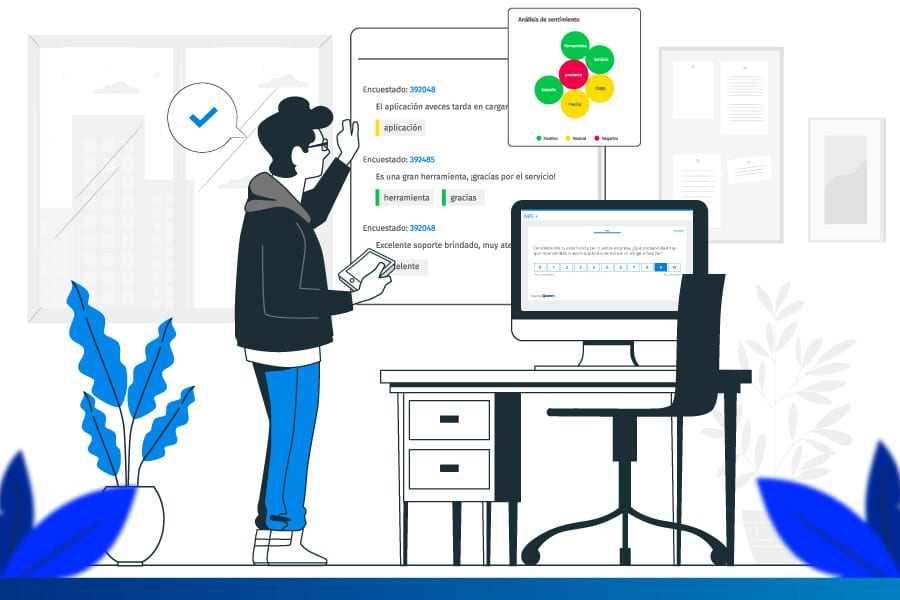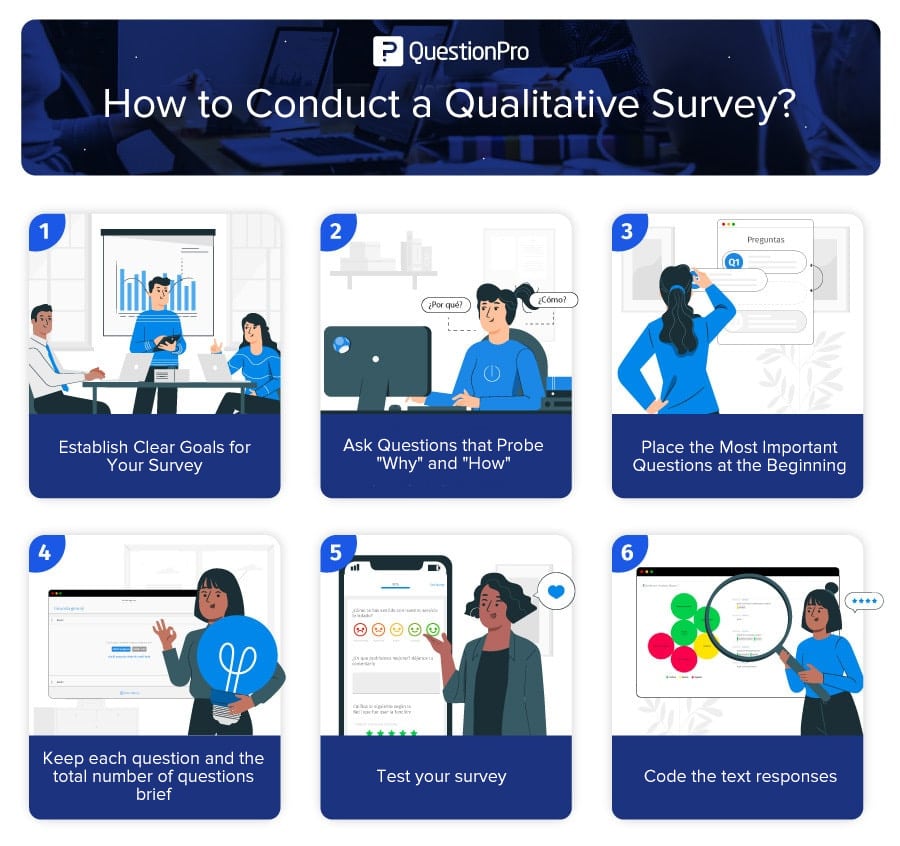
Qualitative surveys have been an essential part of research as they help uncover aspects related to respondents’ emotions, behaviors, and perceptions beyond what numbers can convey.
This article will delve into qualitative surveys in detail, so you can effectively use them in your next study.
What are Qualitative Surveys?
Qualitative surveys are a research tool that employs open-ended questions to gather opinions, experiences, narratives, or accounts from respondents.
These surveys are useful for generating information through a conversation that identifies initial topics or issues to explore further in research.
Qualitative surveys seek comments, opinions, suggestions, and other types of responses that are not as easy to classify and quantify as numbers. Typically, fewer people may be surveyed compared to quantitative surveys, but richer data can be obtained.
Benefits of Qualitative Surveys
Opinions can change and evolve throughout a conversation; qualitative research can capture this. Here are some benefits of using qualitative surveys:
Capture Changing Attitudes
Researchers can quickly adapt questions, change the environment, or other variables to enhance responses if useful data isn’t obtained. Qualitative research can capture changing attitudes within a target group, such as consumers of a product or service or attitudes in the workplace.
Greater Flexibility
If responses don’t align with researcher expectations, qualitative data is equally useful for adding context and perhaps explaining something that numbers alone cannot reveal.
In-Depth Explanation
Qualitative research methods don’t have the same limitations as quantitative methods. When collecting non-numeric data, there’s the potential to provide explanations that reveal more about the data.
Explore Uncharted Areas
Qualitative surveys allow speculative research into areas that researchers find valuable. Capturing qualitative data empowers researchers to be more speculative about the areas they choose to investigate and how to do so.
Enhance Participation
Using qualitative surveys allows for a more direct approach to research participants, who may feel more listened to and motivated to complete the survey.
Types of Qualitative Surveys
There are numerous types of Qualitative Surveys, each offering a distinct approach to comprehending human experiences and perspectives. The selection of a method depends on research objectives, context, and available resources.
Some common types of qualitative surveys include:
Face-to-Face Surveys
In face-to-face surveys, the researcher asks participants one or more open-ended questions on a topic, usually observing participants’ facial expressions and other behaviors while they respond.
Being able to see participants’ reactions allows the researcher to ask follow-up questions for more detailed responses and record any facial or behavioral cues that seem contrary to what participants are explicitly saying.
Phone Surveys
Phone-based qualitative surveys are similar to face-to-face methods, but the researcher cannot see participants’ facial or behavioral responses to the questions asked. This means the researcher must rely on vocal clues.
Online Qualitative Surveys
Online surveys can collect more responses within a shorter time frame than in-person or phone surveys. Although the data may be less detailed, it is generally more abundant to compensate.
Open-ended questions are presented to participants in written format via email or online survey software, often alongside quantitative survey questions on the same topic.
Researchers may provide contextual information or key definitions to help “frame” how participants view qualitative survey questions, as they cannot directly ask the researcher about it in real-time.
Observational Studies
Observational studies involve systematically observing participants in their natural environments. This method provides insights into behaviors, interactions, and contextual factors.
You may be interested in: What is a Longitudinal Study?: Definition and Explanation
Grounded Theory
Grounded theory aims to develop theories from the data itself, allowing researchers to derive concepts and relationships directly from participants’ responses.
Focus Groups
In a focus group, a small group of participants discuss a specific topic or issue under the guidance of a moderator. This method encourages participants to interact with each other, generating rich discussions.
How to Conduct a Qualitative Survey
Here’s a step-by-step guide on how to conduct a qualitative survey in 7 steps:

1. Set Clear Objectives for Your Survey
Determine the purpose of your survey and be clear about what you want to know and the information you expect to gather. Plan precisely how you’ll record response data, including using specific tables or charts that are useful for report generation.
2. Craft Questions that Probe “Why” and “How”
Qualitative research aims to take a concrete idea, delve into why it exists, and determine how it has come about.
With that in mind, your survey questions should be phrased and sequenced to elicit these types of insights. For instance, use open-ended text questions.
3. Place Key Questions at the Start
If you have a set of questions that you deem more important than others, place these questions at the beginning of your survey. Respondents may become fatigued after answering multiple questions, and if respondents stop responding to the survey after partially completing it, their response data will be severely affected.
Ensuring each question serves a purpose can mitigate survey fatigue, and it’s also a good idea to place the most important questions at the beginning.
4. Be Concise in Each Question and the Number of Questions
Responses to survey questions should be intuitive and straightforward for respondents. Therefore, complex instructions shouldn’t be necessary.
Furthermore, each additional question reduces response rates, decreases validity, and makes all results suspect.
People are much more likely to participate in single-question surveys. Therefore, realistically estimate the time needed to complete the survey, as the more open-ended questions and complex classifications you ask people, the more respondents you’ll lose.
5. Test Your Survey
Before using your survey in the actual research, it’s important to conduct a test to determine if the questions you’ve developed yield the responses you expect. This involves creating a draft of the questions and obtaining feedback from collaborators.
Test the survey system’s format with a small group of testers from your target audience, collecting feedback on each page, and examine the results of the test survey to ensure that the collected data is in a useful and analyzable format.
6. Code Text Responses
Researchers often talk about coding data during analysis. This involves converting text responses into something countable so that the most important trends can be extracted and communicated in a way that makes sense to the report’s audience.
Coding text responses allows you to capture rich textual data for understanding and quoting.
Create Your Qualitative Surveys with QuestionPro!
QuestionPro is currently the most comprehensive tool for conducting qualitative surveys due to its integration of open-ended questions and as software for qualitative data analysis.
Interested in exploring these features in detail? Take a free trial of our Advanced license!







